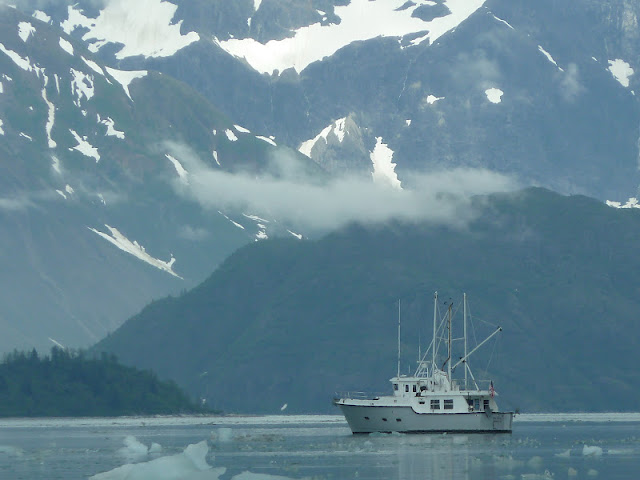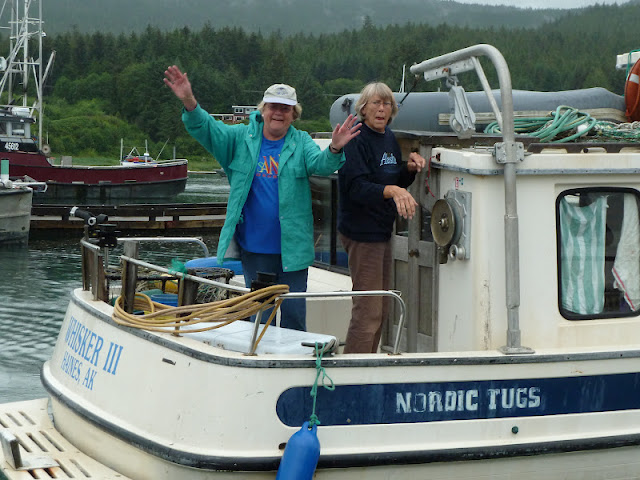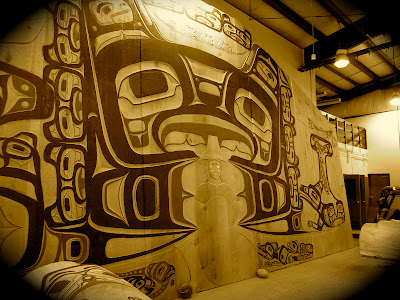Correction from the last blog; Whitehorse is NOT in British Columbia. I know that and I apologize to everyone in the Yukon Territory and British Columbia.
I have four words to Glacier Bay National Park: wet, magnificent, enormous -- in that order.
WET: We had one sunny day out of seven. But what can we say? We’re in Southeast. As one mom on the dock in Hoonah told her daughter, There is no bad weather. Just the wrong clothing. We had the appropriate clothing and it all hung out (literally) in the pilot house to dry. On our tour of the Park on the Baranof Wind, Randy, the Park Naturalist, apologetically told us it was the wettest day he had seen in his six summers in the Park. BUT it was not the worst visibility. We could see the sides of the fiords....most of the time.
We didn’t’ see him land or take off. He was just sitting there in the rain and berggie bits.
 |
| Ghost ship. |
Are we cold? Not so much. Wet? You bethca’
MAGNIFICENT: We visited five glaciers and saw others carving their way down their mountains. We saw ice bergs and a glacier calving. We saw moose and seals and sea lions and birds and bears and wolves(!) and whales. We saw clouds protecting the mountains and then parting into wispy strands to show us rocks and snow-covered peaks and myriad shades of green and gray. We saw brown glacier-melt water and bright Caribbean-blue water.
Margerie Glacier was the first glacier we visited, and, I thought, the most impressive: tall (250 feet above sea level, 50-100 feet below) and pretty. And she is stable, neither receding or advancing. I think she knew we were watching, ohhing and ahhing when she calved and silently taking in her colors and contours.

Grand Pacific Glacier, adjacent to Margerie. His face is very dirty; at first, I thought he was a huge bank of dirt. He is the biggest glacier we visited: 2 miles wide and 35 miles long. And he has dual citizenship. The face is only a few miles (25?) inside the US boarder. Someday he will be a Canadian Citizen (BC). Yes, there will be a quiz at the end of the blog. Open computer.

Lamplugh Glacier, our third glacier on the Baranof Wind tour. Each glacier does have it’s own personality. I like Lamplugh’s cave and wondered how long it will be before it’s ceiling becomes berggie bits..

ENORMOUS: Although we traveled each day, we only covered a fraction of the Park. Twenty-five pleasure boats are allowed in the Park at a time; we rarely saw any of them. I was glad we had company on Greywolf. In the Inside Passage, we have gone for days without seeing another boat, and certainly being the only boat is an anchorage is not unusual, but Glacier Bay FELT big.
We talked with several cruisers who always take their Glacier Bay guests on a tour of the Park on the Baranof Wind. Since the Park is so large, the tour gives a good overview in a short (eight hour) period of time. We knew that the tour boat could get closer to the glaciers through the berggie bits and would certainly exceed Greywolf’s leisurely pace. We signed up.

Baranof Wind note: Approaching Ketchikan three weeks later, I was talking on the phone with my sister and mentioned that one of the smaller (700 feet) cruse ships, the Vonderdam, ahead of us was not getting any respect in Tongas Narrows and was on the VHF radio for the third time to ask another vessel what its intentions were.
Are you planning to continue to cross in front of me?
That’s my plan.
Then I suggest you speed up.
Good idea.
Oh! Joani said. That’s the boat that transferred the passengers off a tour boat in Glacier Bay.
It seems Captain Bob was trying to get close to shore to give the passengers a good view of a brown bear. Bummer. Those skippers are under pressure to give the customers a good experience.
Numbers to validate ENORMOUS: Glacier Bay National Park and Preserve’s 3.3 million acres is part of a 24 million acre UNESCO designated World Heritage Site, one of the largest protected natural areas in the world. Looking at a map of the Heritage Site, you can see that it includes Canadian and US territory. You can also see a little white clump of land boarding the Gulf that is not part of the Heritage Site. A Wall-Mart? Who held out, refusing to ceed control to UNESCO? The Tongas National Forest. Really? They couldn’t spare that chunk of land? Maybe there is more to the story.

The Park staff has a strict protocol for visiting boaters. You contact the Park on the VHF radio before crossing the boundary. You stay one mile off shore (whale protection) near the entrance. You proceed at less than 13 knots (why 13 and not 12 or 14???) in Bartlett Cove. You make a 90 degree turn to the Park dock. You then attend an orientation session where you are informed about the other Park rules. Everything is designed to keep the impact on the wildlife at minimum. The off-limits areas are constantly being revised as animal populations move.
As soon as we tied up at Bartlett Cove, the only dock in the Park, Allie launched herself off the boat as she always does, and landed in the water between the boat and the dock. I didn’t realize that I had her retractable leash in the lock position and had only given her enough rope to hang herself. Knut, the skipper of a Salty Dawg, a Nordic Tug we had met in Hoonah, had taken our lines as we tied up. He now took our dog’s harness and hauled her out. She was so excited to be be on a dock, we didn’t even bother to dry her off. She attended the orientation session, totally approving of the brand of dog treats offered. She didn’t know that Bartlett Cove would be her last opportunity to touch land for a week. Dogs are not allowed on shore in other parts of the Park.
Jolie and Bob’s Alaska Airlines plane landed at Gustavus, ten miles away and they stepped out of the taxi in Summer Clothing.
Seattle: 2:30 PM, 95 degrees. Sun.
Gustavus, 4:40 PM 55 degrees. Rain.
Luggage and backpacks spewed out their contents which were stowed in the guest stateroom A.K.A. walk-in closet.

Vessels can only stay at the Bartlett Cove dock for three hours; Greywolf found herself a comfy spot to anchor.

We then went through a circus of launching Pup. Having our daughter on board apparently reminded us of how old we are. We couldn’t get the correct lines loosened and made off. As these two old people stared up into the rain at the lines, booms, mast, and electric motors saying, “How have we done this in the past???”, I know that Jolie was ready to have the Coast Guard confiscate the boat and put us in The Home.

Monday morning we donned rain gear and life jackets and piled into Pup, headed for the Baranof Wind AND our free souvenir mug!

Our Naturalist, Randy, had wonderful information about the Park and the animals. I wish I could remember it...
This covers our first day. I thought I’d get the entire adventure in this blog, but since I have difficulty being concise and since we have to leave at oh’dark hundred for Grenville Channel (We’re in Prince Rupert, BRITISH COLUMBIA.), I’m going to send the second installment when we next have internet.




















































